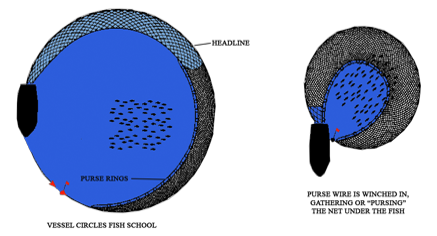PURSE SEINERS WORKING



OVERVIEW
Tuna purse seining involves surrounding tuna shools with a net, impounding the fish by pursing the net, and drying up the catch by hauling the net so that the fish are crowded in the bunt and can then be brailed out.
FISHING GEAR
The industrial purse seine gear is a large net which is used to encircle the school of tunas and closed at the bottom to entrap them. The synthetic net measures 1500 to 2000 m long and 120 to 250 m depth. The size of the mesh is usually around 120 mm stretched mesh. The top of the net is mounted on a floatline and the bottom on a leadline which, usually consists of a steel chain with steel rings, known as "purse rings", are attached below the chain; the purse line which run through the purse rings is made of steel and allow the pursing of the net.
HOW A PURSE SEINE WORKS
In a purse seine the top of the net is floated at the ocean’s surface and the bottom of the net has weights attached that pull the walls of the net downwards.
The bottom of the net has a wire threaded through it which is pulled and tightens the net like a purse trapping the fish inside.
The net is then pulled in toward the boat and the catch is either pumped or lifted out with small nets or the whole net is brought aboard.
FISHING OPERATIONS
The fishing operations realised by a purse seiner to catch tuna, from the beginning of the shooting of the net up to the end of the hauling, back on board of the seine (ready for a new shooting), are called a "set".
1. When a school is detected, the vessel places itself on the right side of the school. For the correct positioning of the vessel versus the fish school, the direct observation from the crows nest, at the top of the mast, directs the vessel movement. The skiff, a highly powered annex, attached to one extremity of the purse seine and having one extremity of the purse line cable (whereas the other extremity of this cable is attached to the winch on the purse seiner) which is kept on the top of the net at the sloped part of the stern of the vessel, is released.
2. The vessel then encircles the school at maximum speed. Usually, all the purse seine is set and the circle is closed within 4 to 8 minutes. When the school is inside of the net, the end of the net is closed and the bottom is pursed.
3. Once the encirclement is finished, the extremity of the net that stayed attached to the skiff is transferred aboard the purse seiner and the two extremities of the purse line cable are hauled with the winch as quickly as possible in order to close the net at its bottom (this is called "pursing" because it is similar to pulling the draw string of an old-fashioned purse).
4. The net is then pulled aboard the purse seiner with a hydraulic power block which is, on board industrial purse seiners, attached to the end of the boom and hanging above the deck. Under the power block, the net is stacked on the stern of the boat by fishermen in such a way that it will come smoothly off the stern at the beginning of the next set. As a whole, this operation will, if there is no incident, take around one hour, or even longer, depending on the size of the net and catch.
5. When most of the purse seine has been retrieved, the tunas have been grouped within a restricted area along the portside of the vessel. Then the fish are harvested from the purse seine using a large scoopnet called the "brailer" (brailing operation); several tonnes of fish are taken on board each time. The duration of this operation will obviously depend upon the quantity of fish in the net.
In tuna fishing off Australia, the pursing is stopped a half way, where the fish are not yet so much aggregated. This is to keep the fish well alive.






